| Author |
Message |
David Black Mastro

|
 Posted: Tue 06 Sep, 2005 12:41 pm Post subject: Earliest schiavona basket-hilts? Posted: Tue 06 Sep, 2005 12:41 pm Post subject: Earliest schiavona basket-hilts? |
 |
|
The schiavona is generally regarded as a sword which came into being in the 17th century, and yet there are some Venetian swords from at least the 1540s onward, that look rather schiavona-like. In addition, Castle in his Schools and Masters of Fence shows a photo of a "Venetian Broadsword, middle sixteenth century" which is "an early specimen of the type 'Schiavona'"--is his dating wrong?
Any input would be appreciated.
"Why meddle with us--you are not strong enough to break us--you know that you have won the battle and slaughtered our army--be content with your honor, and leave us alone, for by God's good will only have we escaped from this business" --unknown Spanish captain to the Chevalier Bayard, at the Battle of Ravenna, 1512
|
|
  |
 |
Nathan Robinson
myArmoury Admin


|
 Posted: Tue 06 Sep, 2005 1:45 pm Post subject: Posted: Tue 06 Sep, 2005 1:45 pm Post subject: |
 |
|
My thought is that the fully developed schiavona is a 17th century (and onwards) creature. While there are Italian and, most often, South German basket-hilts dating from earlier that resemble, and are likely, progenitors of the fully developed schiavona, these are just that: ancestors of the type. I find early dates attached to fully developed examples of the schiavona to be suspect, personally.
.:. Visit my Collection Gallery :: View my Reading List :: View my Wish List :: See Pages I Like :: Find me on Facebook .:.
|
|
    |
 |
David Black Mastro

|
 Posted: Tue 06 Sep, 2005 1:51 pm Post subject: Posted: Tue 06 Sep, 2005 1:51 pm Post subject: |
 |
|
| Nathan Robinson wrote: | | My thought is that the fully developed schiavona is a 17th century (and onwards) creature. While there are Italian and, most often, South German basket-hilts dating from earlier that resemble, and are likely, progenitors of the fully developed schiavona, these are just that: ancestors of the type. I find early dates attached to fully developed examples of the schiavona to be suspect, personally. |
Much obliged, Nathan.
BTW, does anyone have any photos of the espadas Eslavonas listed in Charles V's Relacion de Valladolid of 1557? Oakeshott says they are similar to swords with "horizontally recurved crosses" which can be found "in large numbers in Venice" and elsewhere.
"Why meddle with us--you are not strong enough to break us--you know that you have won the battle and slaughtered our army--be content with your honor, and leave us alone, for by God's good will only have we escaped from this business" --unknown Spanish captain to the Chevalier Bayard, at the Battle of Ravenna, 1512
|
|
  |
 |
William Goodwin

|
 Posted: Tue 06 Sep, 2005 1:59 pm Post subject: Posted: Tue 06 Sep, 2005 1:59 pm Post subject: |
 |
|
Have to agree with Nathan. Like the Mortuary hilt (  ), the Schiavona is only found to be made & in use (for the most part) during the 17th c. ), the Schiavona is only found to be made & in use (for the most part) during the 17th c.
Bill
Roanoke Sword Guilde
roanokeswordguilde@live.com
"I was born for this" - Joan of Arc
|
|
   |
 |
Thomas McDonald
myArmoury Alumni


|
 Posted: Tue 06 Sep, 2005 3:40 pm Post subject: Posted: Tue 06 Sep, 2005 3:40 pm Post subject: |
 |
|
Claudio's page, at: http://www.catsdiablopage.com/weapons1.htm, lists this piece as German, c. 1590.
The basket is typical of what some speculate as early schiavona, albeit German made, yet this one does have a cats head pommel, so I dunno ...... Pommel replacement ?, wrong date assigned ?
Mac

'Gott Bewahr Die Oprechte Schotten'
XX ANDRIA XX FARARA XX
Mac's PictureTrail
|
|
   |
 |
Kirk Lee Spencer

|
 Posted: Tue 06 Sep, 2005 4:20 pm Post subject: Posted: Tue 06 Sep, 2005 4:20 pm Post subject: |
 |
|
Possible "missing links" ... late 16th century... 
ks
 Attachment: 83.02 KB Attachment: 83.02 KB
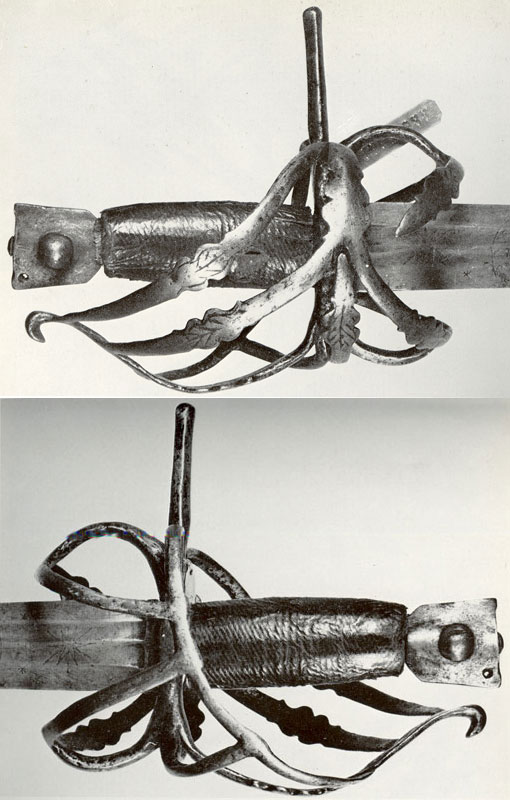
From “Armi Bianche Italiane” by Boccia, Lionello G. and Coelho, Eduardo T. 1975 Bramante Editrice c.1590
 Attachment: 99.67 KB Attachment: 99.67 KB
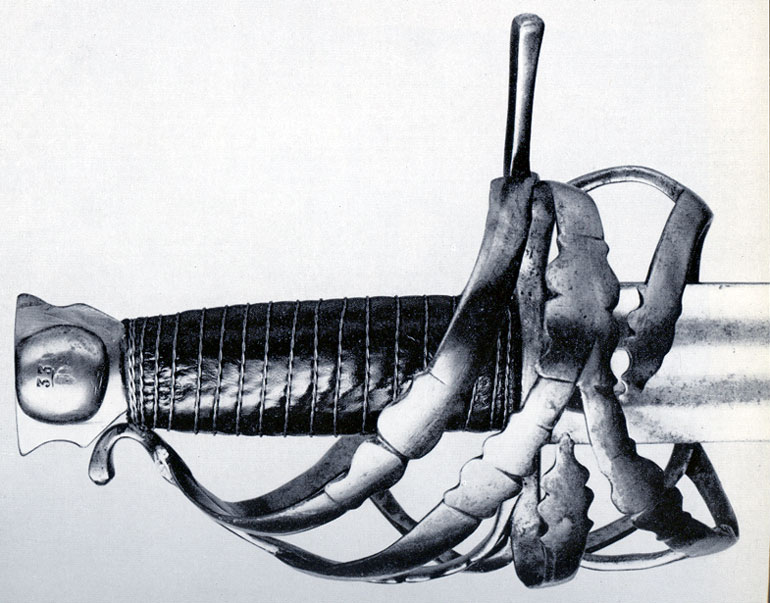
“Armi Bianche Italiane” by Boccia, Lionello G. and Coelho, Eduardo T. 1975 Bramante Editrice, c. 1590
Two swords
Lit in Eden’s flame
One of iron and one of ink
To place within a bloody hand
One of God or one of man
Our souls to one of
Two eternities
|
|
  |
 |
David Black Mastro

|
 Posted: Tue 06 Sep, 2005 5:13 pm Post subject: Posted: Tue 06 Sep, 2005 5:13 pm Post subject: |
 |
|
Thomas & Kirk,
Thanks for the pics--those are really nice pieces.
I guess what I'm confused about is the fact that the earlier, pre-basket-hilt swords from Balkans are known as espada Eslavona or spada Schiavona, and it is thought the the later "true" schiavona was likewise termed as such. If this is the case, then wouldn't it be likely the the "missing link" transitional forms would be known as such too?
Best,
David
"Why meddle with us--you are not strong enough to break us--you know that you have won the battle and slaughtered our army--be content with your honor, and leave us alone, for by God's good will only have we escaped from this business" --unknown Spanish captain to the Chevalier Bayard, at the Battle of Ravenna, 1512
|
|
  |
 |
Kirk Lee Spencer

|
 Posted: Sat 10 Sep, 2005 11:28 am Post subject: Posted: Sat 10 Sep, 2005 11:28 am Post subject: |
 |
|
| David Black Mastro wrote: | .
I guess what I'm confused about is the fact that the earlier, pre-basket-hilt swords from Balkans are known as espada Eslavona or spada Schiavona, and it is thought the the later "true" schiavona was likewise termed as such. If this is the case, then wouldn't it be likely the the "missing link" transitional forms would be known as such too?
|
Hi David...
Best I can remember from Oakeshott, the word "schiavona" was the Italianized version of "eslavona". Both words indicate the slavic origins of the distinctive cats-head pommel (katzenkopknauf... or some such.) Slavic mercenaries hired by the "council of ten" brought these slavic forms (squarish pommel and horizontally strongly curved guards) to Venice. I believe the pre-basket-hilt forms you are referring to would more likely bear the name "schiovonese" and would not be known as "schiavona" until the basket was added from more German influence.
In short the Schiavona is a blend of Schiovonese elements (pommel and cross) from the Balkans and more German basket forms. As such, while definitely and ancestrial form (as Nathan said earlier in the thread), the earlier non-basket forms would not be called "schiavona" but "schiavonese".
As for missing links... Oakeshott has a diagram of his view of the evolution in his "European Weapons and Armour" (the follow up work to his "Archeology of Weapons") He also includes a drawing of a sword in the collection of Dr Giorgio Bini that is the closest thing to a missing link as I have seen. It has the curved guards and early cathead pommel of the Schiavonese and the forward guards and swept knuckle guards of the German forms. As for your last question of what these missing links would be called... What we would call them today depends on our typology I suppose.
I have seen archeologists classify it in a category and then say with affinities to another type ("Early Schiavona with Schiavonese affinities").
They also use variants of main types ("Schiavona Schiavonese variant").
Or they just use the classificatrion of "unclassified" forms ("early unclassified schiavona").
As for what the "missing links" were called way back then, it is really hard to say... probably something like, "my new one-of a-kind custom sword" 
hope this helps...
ks
 Attachment: 90.71 KB Attachment: 90.71 KB
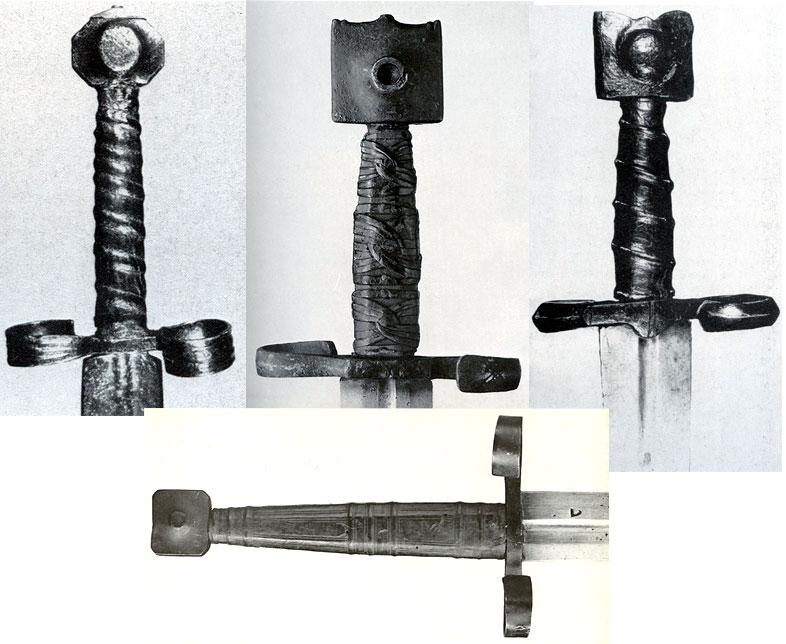
Left and Right from "The Sword in the Age of Chivalry" Oakeshott
Middle and Bottom from “Armi Bianche Italiane” by Boccia, Lionello G. and Coelho, Eduardo T. 1975 Bramante Editrice
 Attachment: 79.72 KB Attachment: 79.72 KB
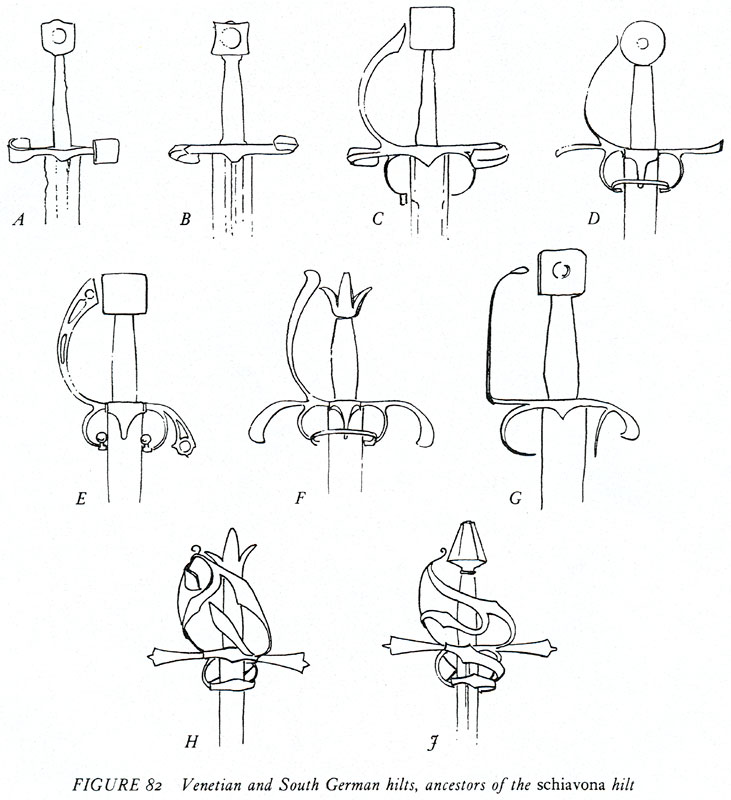
From "European Weapons And Armour" Ewart Oakeshott
 Attachment: 57.76 KB Attachment: 57.76 KB
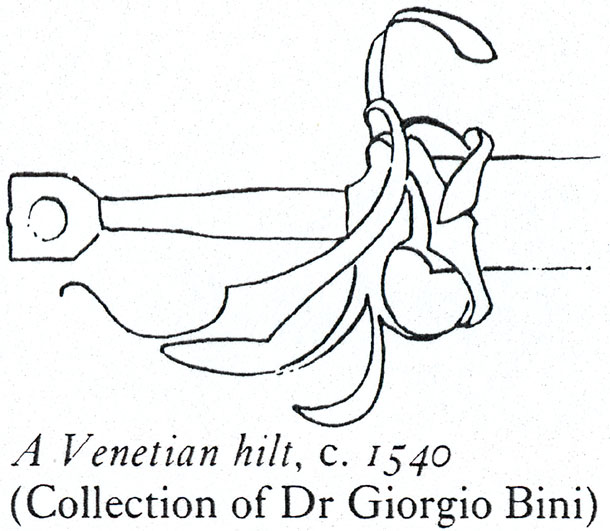
From "European Weapons And Armour" Ewart Oakeshott
Two swords
Lit in Eden’s flame
One of iron and one of ink
To place within a bloody hand
One of God or one of man
Our souls to one of
Two eternities
|
|
  |
 |
|
|
You cannot post new topics in this forum
You cannot reply to topics in this forum
You cannot edit your posts in this forum
You cannot delete your posts in this forum
You cannot vote in polls in this forum
You cannot attach files in this forum
You can download files in this forum
|
All contents © Copyright 2003-2025 myArmoury.com — All rights reserved
Discussion forums powered by phpBB © The phpBB Group
Switch to the Basic Low-bandwidth Version of the forum
|

